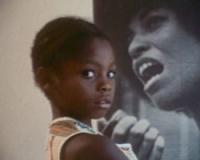The L.A. Rebellion symposium opened Saturday morning with a welcome and introduction by Allyson Nadia Field and Jacqueline Stewart, who contextualized the symposium in relation to the history of the L.A. Rebellion and the current UCLA initiative. Dr. Field’s introduction described the project and the ventures being developed as a part of it that will provide invaluable resources and lasting platforms for ongoing research and investigation into the movement and its lasting impact. Dr. Stewart extended the historical framework to consider the influence of Elyseo Taylor, the first African American faculty member at the UCLA School of Theater, Film and Television, who was central to developing the institutional and critical frameworks for engaging and supporting minority film production at the university. Deeply influenced by Third Cinema’s political commitments, Taylor advocated an approach to filmmaking in which communities could be in dialogue with themselves, examining the issues affecting them in their own terms. Taylor supported film practice that could debate solutions to these issues, and so have an effect on the social reality of those communities that the films were concerned to represent.
Ultimately—and controversially—Elyseo Taylor was denied tenure by the university and left UCLA. He was succeeded by Teshome Gabriel, who, as Dr. Stewart described, picked up the mantle and continued to examine the intersections between film, history, identity and community through the lenses and politics of Third Cinema. Gabriel’s passing in 2010 marked a profound loss for minority filmmaking at UCLA and beyond. Taylor’s and Gabriel’s lasting impact can be seen in the work that they have supported and produced (please visit Gabriel’s critical and academic contributions), and at UCLA, the School of Theater, Film and Television continues to offer course FTV 112 – Film and Social Change, a course pioneered by Taylor and that was taught by Gabriel for many years.
Their legacies open up questions for any institution supporting minority filmmaking: in addition to the commitment and drive of individuals such as Taylor and Gabriel, and projects such as the LA Rebellion initiative, how do institutions create stable and lasting support for minority filmmaking? What institutional changes need to accompany such support? And what processes need to be in place in order to accomplish these changes?
—Karrmen Crey






 Mobile Navigation
Mobile Navigation

